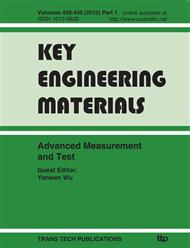[1]
Steven Henikoff1 and Jorja G. Henikoff, Position-based sequence weights, J Mol Biol. Vol. 243(4) (1994), pp.574-578.
Google Scholar
[2]
Prakash, A. Tompa, M. Assessing the Discordance of Multiple Sequence Alignments, IEEE/ACM Transactions on Computational Biology and Bioinformatics, vol. 6(4) (2009), pp.542-551.
DOI: 10.1109/tcbb.2007.70271
Google Scholar
[3]
Thompson JD, Higgins DG, Gibson TJ: CLUSTAL W: improving the sensitivity of progressive multiple sequence alignment through sequence weighting, position-specific gap penalties and weight matrix choice. Nucl. Acids Res. Vol. 22(22) (1994).
DOI: 10.1093/nar/22.22.4673
Google Scholar
[4]
Lee A. Newberg, Lee Ann McCue, Charles E. Lawrence, The relative inefficiency of sequence weights approaches in Determining a Nucleotide position weight matrix, Stat Appl Genet Mol Biol. Vol. 4(1) (2005), article 13.
DOI: 10.2202/1544-6115.1135
Google Scholar
[5]
C. Notredame. Recent Progress in Multiple Sequence Alignment: A Survey, Pharmacogenomics, vol. 3(1) (2002), pp.131-144.
DOI: 10.1517/14622416.3.1.131
Google Scholar
[6]
Christian Blum, MariaJ. Blesa, ManuelLópez-Ibáñez. Beam search for the longest common subsequence problem, Computers & Operations Research 36 (2009), pp.3178-3186.
DOI: 10.1016/j.cor.2009.02.005
Google Scholar
[7]
Cao Zhanmao, Hong Shen, Gong Leiguang. A Beam-through Algorithm to compute Multiple Sequence Alignment, Proceedings of International Conference on Machine Learning and Cybernetics. Vol. 9 (9) ( 2005), pp.5704-5712.
DOI: 10.1109/icmlc.2005.1527954
Google Scholar
[8]
C. Notredame, D.G. Higgins, and J. Heringa, T-Coffee: A Novel Method for Fast and Accurate Multiple Sequence Alignment, J. Molecular Biology, vol. 302(1), (2000), pp.205-217.
DOI: 10.1006/jmbi.2000.4042
Google Scholar
[9]
McCue LA, Thompson W, Carmack CS, Lawrence CE. Factors influencing the identification of transcription factor binding sites by cross-species comparison. Genome Res. Vol. 12(10), (2002), pp.1523-1532.
DOI: 10.1101/gr.323602
Google Scholar
[10]
Bruno WJ. Modeling residue usage in aligned protein sequences via maximum likelihood. Mol Biol Evol. Vol. 13(10), (1996), pp.1368-1374.
DOI: 10.1093/oxfordjournals.molbev.a025583
Google Scholar
[11]
Xin Chen, Tao Jiang, An improved Gibbs sampling method for motif discovery via sequence weighting, Journal: Computational systems bioinformatics / Life Sciences Society. Computational Systems Bioinformatics Conference, (2006), pp.239-247.
DOI: 10.1142/9781860947575_0030
Google Scholar
[12]
S. Altschul, W. Gish, W. Miller, E. Myers, and D. Lipman. Basic local alignment search tool. Journal of Molecular Biology, 215, (1990), pp.403-410.
DOI: 10.1016/s0022-2836(05)80360-2
Google Scholar
[13]
S. Altschul. Evaluating the statistical significance of multiple distinct local alignments. In S. Suhai, editor, Theoretical and Computational Methods in Genome Research, (1997), pp.1-14.
DOI: 10.1007/978-1-4615-5903-0_1
Google Scholar
[14]
S. Karlin and S.F. Altschul. Methods for assessing the statistical significance of molecular sequence features by using general scoring schemes. Proceedings of the National Academy of Science USA, 87(6), (1990), pp.2264-2268.
DOI: 10.1073/pnas.87.6.2264
Google Scholar
[15]
T. Jiang and L. Wang, On the Complexity of Multiple Sequence Alignment, J. Computer Biology. Vol. 1(4), (1994), pp.337-348.
Google Scholar


